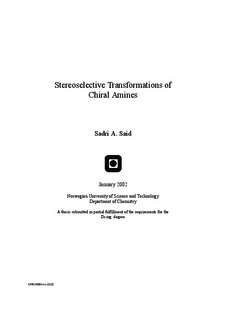| dc.contributor.author | Said, Sadri A. | nb_NO |
| dc.date.accessioned | 2014-12-19T13:11:00Z | |
| dc.date.available | 2014-12-19T13:11:00Z | |
| dc.date.created | 2002-04-19 | nb_NO |
| dc.date.issued | 2002 | nb_NO |
| dc.identifier | 126329 | nb_NO |
| dc.identifier.isbn | 82-471-5399-8 | nb_NO |
| dc.identifier.uri | http://hdl.handle.net/11250/244544 | |
| dc.description.abstract | Enantiomerically pure amines and alcohols are particularly important synthons for the preparation of pharmaceuticals and agrochemicals. Notwithstanding the advances that have been achieved in asymmetric synthesis, resolution of racemates is probably the most current approach for the preparation of pure enantiomers. On the other hand, resolution processes suffer from disadvantages of low yields caused by the loss of at least 50% of the undesired isomer. Among the attractive methods for avoiding the drawbacks of resolution processes is inversion of configuration of the unwanted isomer. Although there are several existing methodologies for inversion and stereoselective transformations of chiral alcohols, corresponding methods for inversion of chiral amines has received less attention. The main objective of the project “Stereoselective transformations of chiral amines” was therefore to develop effective methods for inversion and stereoselective transformations of chiral amines.
This thesis discuss the utility of three nucleophilic substitution methods in stereoselective transformations of chiral amines.
The first investigation towards this goal was carried out using cyclic aryldisulfonylimide leaving group. Substitution of a chiral amine via N,Nnaphthalene- 1,2-disulfonylimide intermediate gave azide and alcohol products with 60-73% inversion of configuration, which was 20-25% lower compared to the previously studied relative disulfonylimides. Displacement of this group using aroxide anions afforded chiral aryl ethers with 70-87% inversion of stereochemistry. Chiral analysis of the ether products required synthesis of authentic reference compounds. This was achieved via benzyne route and by nucleophilic substitution on the derivatives of chiral alcohols. The benzyne route gave chiral phenyl ether from enantiopure alcohols with complete retention of configuration while the trifluoroacetate derivatives of chiral alcohols produced chiral aryl ethers with complete inversion of stereochemistry.
The 2,4,6-triphenylpyridinium cations were the next intermediates investigated in this study. These derivatives were synthesized from 2,4,6-triphenylpyrylium tetrafluoroborate in 84-90% yields using procedures described by Katritzky. Nucleophilic substitution on pyridinium salts of aliphatic chiral amines using azide and hydroxide anions gave products with 96 to 100% inversion of configuration.
The utility of diazonium salts for inversion of chiral amines was also investigated in the present study. This method was only focused on stereoselective transformations of α-amino acids as diazotization-dediazoniation of other aliphatic amines is of little interest for organic synthesis. Diazotization of L-alanine and L-phenylalanine ethyl esters hydrochlorides using alkyl nitrites in aprotic solvents, in the presence of azide anion, yielded optically active chloro substituents as the only products, instead of the intended azide compounds. Attempts to avoid counterion substitution by using ammonium tosylate to replace the ammonium chlorides was not useful and a tosyl product was isolated instead. Proposals to rectify this problem have been suggested. These include the use of much more inert counterions such as tetrafluoroborate or replacing the hydrochlorides with hydroazides. An alternative which could deliver the nucleophile in an intramolecular fashion has also been postulated. Investigations of these hypotheses are currently conducted.
Parallel to diazotization reactions was an investigation on inversion of α-amino acids via N,N-disulfonylimides and 2,4,6-triphenylpyridinium cation leaving groups. Studies with N,N-disulfonylimide derivatives showed that this leaving group is not useful for inversion of α-amino acids. Nucleophilic substitution on the 2,4,6-triphenylpyridinium salts of amino acids afforded partial racemized substitution products. The drawback in the utility of the pyridinium salts has been identified and efforts are underway to remove this impediment. | nb_NO |
| dc.language | eng | nb_NO |
| dc.publisher | Fakultet for naturvitenskap og teknologi | nb_NO |
| dc.relation.ispartofseries | Dr. ingeniøravhandling, 0809-103X; 2002:8 | nb_NO |
| dc.relation.haspart | Said, SA; Fiksdahl, A. Preparation and nucleophilic substitution of the N,N-1,2-naphthalenedisulfonylimide derivative of a chiral amine. Tetrahedron: Asymmetry. 10(13): 2627-2633, 1999. | nb_NO |
| dc.relation.haspart | Said, SA; Fiksdahl, A; Carlsen, PHJ. Stereoselective synthesis of optically active phenyl ether. Tetrahedron letters. 41(29): 5593-5596, 2000. | nb_NO |
| dc.relation.haspart | Said, SA; Fiksdahl, A. Formation of chiral aryl ethers from enantiopure amine or alcohol substrates. Tetrahedron: Asymmetry. 12(6): 893-896, 2001. | nb_NO |
| dc.relation.haspart | Said, SA; Fiksdahl, A. Stereoselective transformation of amines via chiral 2,4,6triphenylpyridinium intermediates. Tetrahedron: Asymmetry. 12(13): 1947-1951, 2001. | nb_NO |
| dc.subject | | en_GB |
| dc.subject | Kemi | en_GB |
| dc.subject | NATURAL SCIENCES: Chemistry | en_GB |
| dc.title | Stereoselective Transformations of Chiral Amines | nb_NO |
| dc.type | Doctoral thesis | nb_NO |
| dc.source.pagenumber | 82 | nb_NO |
| dc.contributor.department | Norges teknisk-naturvitenskapelige universitet, Fakultet for naturvitenskap og teknologi | nb_NO |
| dc.description.degree | dr.ing. | nb_NO |
| dc.description.degree | dr.ing. | en_GB |
